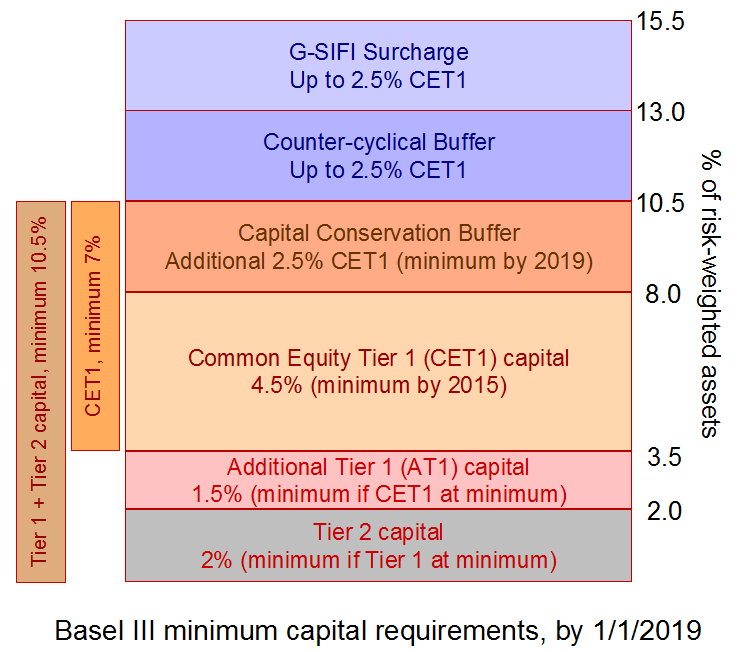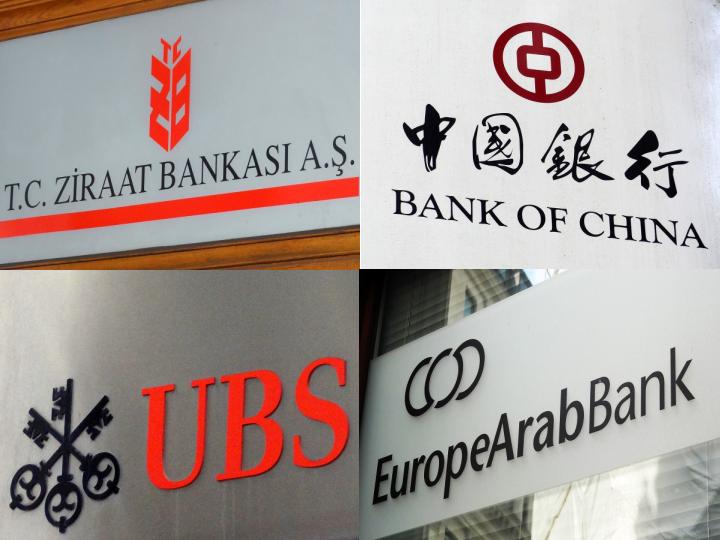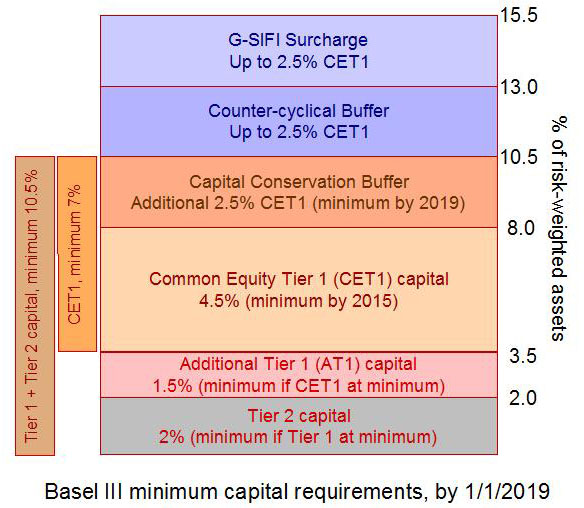 Following the banking crisis of 2007/8 a new set of international banking regulations was agreed in 2010 by the Basel Committee on Banking Supervision. The purpose was to strengthen banks’ capital base. Under ‘Basel III’, banks would be required, in stages, to meet specific minimum capital adequacy ratios: i.e. minimum ratios of capital to (risk-weighted) assets. The full regulations would come into force by 2019. These are shown in the chart below.
Following the banking crisis of 2007/8 a new set of international banking regulations was agreed in 2010 by the Basel Committee on Banking Supervision. The purpose was to strengthen banks’ capital base. Under ‘Basel III’, banks would be required, in stages, to meet specific minimum capital adequacy ratios: i.e. minimum ratios of capital to (risk-weighted) assets. The full regulations would come into force by 2019. These are shown in the chart below.
The new Financial Policy Committee of the Bank of England has judged that some UK banks have insufficient ‘common equity tier 1 capital’. This is defined as ordinary shares in the bank plus the bank’s reserves. According to the Bank of England:
… the immediate objective should be to achieve a common equity tier 1 capital ratio, based on Basel III definitions and, after the required adjustments, of at least 7% of risk-weighted assets by end 2013. Some banks, even after the adjustments described above, have capital ratios in excess of 7%; for those that do not, the aggregate capital shortfall at end 2012 was around £25 billion.
Thus the banking system in the UK is being required, by the end of 2013, to meet the 7% ratio. This could be done, either by increasing the amount of capital or by reducing the amount of assets. The Bank of England is keen for banks not to reduce assets, which would imply a reduction in lending. Similarly, it does not want banks to increase reserves at the expense of lending. Either action could push the economy back into recession. Rather the Bank of England wants banks to raise more capital. But that requires sufficient confidence by investors.
 And the end of this year is not the end of the process. After that, further increases in capital will be required, so that by 2019 banks are fully compliant with Basel III. All this will make it difficult for certain banks to raise enough capital from investors. As far as RBS and the Lloyds Banking Group are concerned, this will make the prospect of privatising them more difficult. But that is what the government eventually wants. It does not want the taxpayer to have to find the extra capital. Re-capitalising the banks, or at least some of them, may prove difficult.
And the end of this year is not the end of the process. After that, further increases in capital will be required, so that by 2019 banks are fully compliant with Basel III. All this will make it difficult for certain banks to raise enough capital from investors. As far as RBS and the Lloyds Banking Group are concerned, this will make the prospect of privatising them more difficult. But that is what the government eventually wants. It does not want the taxpayer to have to find the extra capital. Re-capitalising the banks, or at least some of them, may prove difficult.
The following articles look at the implications of the FPC judgement and whether strengthening the banks will strengthen or weaken the rest of the economy.
Articles
Financial policy committee identifies £25bn capital shortfall in UK banks The Guardian, Jill Treanor (27/3/13)
Banks Told To Raise Capital By Financial Policy Committee To Cushion Against A Crisis Huffington Post (27/3/13)
UK banks’ £25bn shortfall: positive for banks, negative for BoE credibility, Sid Verma (27/3/13)
Doubts over Bank of England’s £25bn confidence game The Telegraph, Harry Wilson (27/3/13)
Bank of England tells banks to raise £25bn BBC News (27/3/13)
Q&A: Basel rules on bank capital – who cares? Laurence Knight (13/9/10)
U.K. Banks Seen Avoiding Share Sales After BOE Capital Review Bloomberg Businessweek, Gavin Finch and Howard Mustoe (27/3/13)
Banks Cut Basel III Shortfall by $215 Billion in Mid-2012 Bloomberg (19/3/13)
Will strengthening banks weaken the economy? BBC News, Robert Peston (27/3/13)
Bank of England News Release
Financial Policy Committee statement from its policy meeting, 19 March 2013 Bank of England (27/3/13)
Questions
- Explain the individual parts of the chart.
- What do you understand by risk-weighted assets?
- Distinguish between capital adequacy ratios and liquidity ratios.
- What could the banks do to increase their capital adequacy ratios? Compare the desirability of each method.
- If all banks around the world were Basel III compliant, would this make another global banking crisis impossible?
 As part of the Basel III round of banking regulations, representatives of the EU Parliament and member governments have agreed with the European Commission that bankers’ bonuses should be capped. The proposal is to cap them at 100% of annual salary, or 200% with the agreement of shareholders. The full Parliament will vote in May and then it will go to officials from the 27 Member States. Under a system of qualified majority voting, it is expected to be accepted, despite UK resistance.
As part of the Basel III round of banking regulations, representatives of the EU Parliament and member governments have agreed with the European Commission that bankers’ bonuses should be capped. The proposal is to cap them at 100% of annual salary, or 200% with the agreement of shareholders. The full Parliament will vote in May and then it will go to officials from the 27 Member States. Under a system of qualified majority voting, it is expected to be accepted, despite UK resistance.
The main arguments in favour of a cap are that it will reduce the focus of bankers on short-term gains and reduce the incentive to take excessive risks. It will also appease the anger of electorates throughout the EU over bankers getting huge bonuses, especially in the light of the recession, caused in major part by the excesses of bankers.
 The main argument against is that it will drive talented top bankers to countries outside the EU. This is a particular worry of the UK government, fearful of the effect on the City of London. There is also the criticism that it will simply drive banks into increasing basic salaries of senior executives to compensate for lower bonuses.
The main argument against is that it will drive talented top bankers to countries outside the EU. This is a particular worry of the UK government, fearful of the effect on the City of London. There is also the criticism that it will simply drive banks into increasing basic salaries of senior executives to compensate for lower bonuses.
But it is not just the EU considering curbing bankers’ pay. The Swiss have just voted in a referendum to give shareholders the right to veto salaries and bonuses of executives of major companies. Many of these companies are banks or other financial sector organisations.
So just what will be the effect on incentives, banks’ performance and the movement of top bankers to countries without such caps? The following videos and articles explore these issues. As you will see, the topic is highly controversial and politically charged.
 Meanwhile, HSBC has revealed its 2012 results. It paid out $1.9bn in fines for money laundering and set aside a further $2.3bn for mis-selling financial products in the UK. But its underlying profits were up 18%. Bonuses were up too. The 16 top executives received an average of $4.9m each. The Chief Executive, Stuart Gulliver, received $14.1m in 2012, 33% up on 2011 (see final article below).
Meanwhile, HSBC has revealed its 2012 results. It paid out $1.9bn in fines for money laundering and set aside a further $2.3bn for mis-selling financial products in the UK. But its underlying profits were up 18%. Bonuses were up too. The 16 top executives received an average of $4.9m each. The Chief Executive, Stuart Gulliver, received $14.1m in 2012, 33% up on 2011 (see final article below).
Webcasts and podcasts
 EU moves to cap bankers bonuses Euronews on Yahoo News (1/3/13)
EU moves to cap bankers bonuses Euronews on Yahoo News (1/3/13)
 EU to Curb Bank Bonuses WSJ Live (28/2/13)
EU to Curb Bank Bonuses WSJ Live (28/2/13)
 Inside Story – Curbing Europe’s bank bonuses AlJazeera on YouTube (1/3/13)
Inside Story – Curbing Europe’s bank bonuses AlJazeera on YouTube (1/3/13)
 Will EU bonus cap ‘damage economy’? BBC Radio 4 Today Programme (28/2/13)
Will EU bonus cap ‘damage economy’? BBC Radio 4 Today Programme (28/2/13)
 Swiss back curbs on executive pay in referendum BBC News (3/3/13)
Swiss back curbs on executive pay in referendum BBC News (3/3/13)
 Has the HSBC scandal impacted on business? BBC News, Jeremy Howell (4/3/13)
Has the HSBC scandal impacted on business? BBC News, Jeremy Howell (4/3/13)
Articles
Bonuses: the essential guide The Guardian, Simon Bowers, Jill Treanor, Fiona Walsh, Julia Finch, Patrick Collinson and Ian Traynor (28/2/13)
Q&A: EU banker bonus cap plan BBC News (28/2/13)
Outcry, and a Little Cunning, From Euro Bankers The New York Times, Landon Thomas Jr. (28/2/13)
Bank bonuses may shrink – but watch as the salaries rise The Observer, Rob Taylor (3/3/13)
Don’t cap bank bonuses, scrap them The Guardian, Deborah Hargreaves (28/2/13)
Capping banker bonuses simply avoids facing real bank problems The Telegraph, Mats Persson (2/3/13)
Pro bonus The Economist, Schumpeter column (28/2/13)
‘The most deluded measure to come from Europe since fixing the price of groceries in the Roman Empire’: Boris Johnson attacks EU banker bonus cap Independent, Gavin Cordon , Geoff Meade (28/2/13)
EU agrees to cap bankers’ bonuses BBC News (28/2/13)
Viewpoints: EU banker bonus cap BBC News (28/2/13)
Voters crack down on corporate pay packages swissinfo.ch , Urs Geiser (3/3/13)
Swiss voters seen backing executive pay curbs Reuters, Emma Thomasson (3/3/13)
Swiss referendum backs executive pay curbs BBC News (3/3/13)
Voters in Swiss referendum back curbs on executives’ pay and bonuses The Guardian, Kim Willsher and Phillip Inman (3/3/13)
Swiss vote for corporate pay curbs Financial Times, James Shotter and Alex Barker (3/3/13)
HSBC pays $4.2bn for fines and mis-selling in 2012 BBC News (4/3/13)
Questions
- How does competition, or a lack of it, in the banking industry affect senior bankers’ remuneration?
- What incentives are created by the bonus structure as it is now? Do these incentives result in desirable outcomes?
- How would you redesign the bonus system so that the incentives resulted in beneficial outcomes?
- If bonuses are capped as proposed by the EU, how would you assess the balance of advantages and disadvantages? What additional information would you need to know to make such an assessment?
- How has the relationship between banks and central banks over the past few years created a moral hazard? How could such a moral hazard be eliminated?
 In the wake of the financial crisis of 2007/8, the international banking regulatory body, the Basel Committee on Banking Supervision, sought to ensure that the global banking system would be much safer in future. This would require that banks had (a) sufficient capital; (b) sufficient liquidity to meet the demands of customers.
In the wake of the financial crisis of 2007/8, the international banking regulatory body, the Basel Committee on Banking Supervision, sought to ensure that the global banking system would be much safer in future. This would require that banks had (a) sufficient capital; (b) sufficient liquidity to meet the demands of customers.
The Basel III rules set new requirements for capital adequacy ratios, to be phased in by 2019. But what about liquidity ratios? The initial proposals of the Basel Committee were that banks should have sufficient liquid assets to be able to withstand for at least 30 days an intense liquidity crisis (such as that which led to the run on Northern Rock in 2007). Liquid assets were defined as cash, reserves in the central bank and government bonds. This new ‘liquidity coverage ratio’ would begin in 2015.
These proposals, however, have met with considerable resistance from bankers, who claim that higher liquidity requirements will reduce their ability to lend and reduce the money multiplier. This would make it more difficult for countries to pull out of recession.
 In response, the Basel Committee has published a revised set of liquidity requirements. The new liquidity coverage ratio, instead of being introduced in full in 2015, will be phased in over four years from 2015 to 2019. Also the definition of liquid assets has been significantly expanded to include highly rated equities, company bonds and mortgage-backed securities.
In response, the Basel Committee has published a revised set of liquidity requirements. The new liquidity coverage ratio, instead of being introduced in full in 2015, will be phased in over four years from 2015 to 2019. Also the definition of liquid assets has been significantly expanded to include highly rated equities, company bonds and mortgage-backed securities.
This loosening of the liquidity requirements has been well received by banks. But, as some of the commentators point out in the articles, it is some of these assets that proved to be wholly illiquid in 2007/8!
Articles
Banks Win 4-Year Delay as Basel Liquidity Rule Loosened BloombergJim Brunsden, Giles Broom & Ben Moshinsky (7/1/13)
Banks win victory over new Basel liquidity rules Independent, Ben Chu (7/1/13)
Banks win concessions and time on liquidity rules The Guardian, Dan Milmo (7/1/13)
Basel liquidity agreement boosts bank shares BBC News (7/1/13)
Banks agree minimum liquidity rules BBC News, Robert Peston (67/1/13)
The agreement
Group of Governors and Heads of Supervision endorses revised liquidity standard for banks BIS Press Release (6/1/13)
Summary description of the LCR BIS (6/1/13)
Basel III: The Liquidity Coverage Ratio and liquidity risk monitoring tools BIS (6/1/13)
 Introductory remarks from GHOS Chairman Mervyn King and the Basel Committee on Banking Supervision’s Chairman Stefan Ingves (Transcript) BIS (6/1/13)
Introductory remarks from GHOS Chairman Mervyn King and the Basel Committee on Banking Supervision’s Chairman Stefan Ingves (Transcript) BIS (6/1/13)
Questions
- What is meant by ‘liquid assets’?
- How does the liquidity of assets depend on the state of the economy?
- What is the relationship between the liquidity ratio and the money multiplier?
- Does the size of the money multiplier depend solely on the liquidity ratio that banks are required to hold?
- Distinguish between capital adequacy and liquidity.
- What has been the effect of quantitative easing on banks’ liquidity ratios?
 Big challenges face the global community in making its financial institutions more resilient to withstand the difficulties that arise from the macroeconomic environment and, at the same time, better aligning their private interests with those of wider society.
Big challenges face the global community in making its financial institutions more resilient to withstand the difficulties that arise from the macroeconomic environment and, at the same time, better aligning their private interests with those of wider society.
This is no easy task. It is not easy either to keep tabs on the international responses to try and deliver these aims.
This is no better illustrated by some of the recent changes to the capital requirements of financial institutions outlined by the Basel Committee on Banking Supervisions. (Click here for a PowerPoint of the above chart.) The so-called Basel III framework will, in effect, increase the capital that banks are required to hold and, in particular, specific types of capital. In the process this will reduce gearing, i.e. the amount of assets relative to capital. Recent announcements have detailed how large global banks will have to hold even more capital. This blog tries to make sense some of the changes afoot. Further reading is identified below.
The details of the Basel III framework are complex, there are an enormous amounts of financial acronyms to sift through and the definitions of capital change from time. But, at the heart of the proposals is the aim of increasing the resilience of our financial institutions. To do this the proposals focus predominantly on the liability side of a bank’s balance sheet. More specifically, they focus on long-term liabilities which help banks to resource their assets, i.e. to fund their provision of credit (their assets). This capital is ranked by its quality or by tiers; this terminology has recently changed.
Tier 1 capital is now split into two groups: Common Equity Capital (CET1) and Additional Tier 1 (AT1). The former – the ‘best’ capital – is made up of common equity (ordinary share capital) and retained profits. Holders of common equity can expect to receive dividend payments, but these are discretionary, largely dependent on the financial well-being of the firm. The remainder of CET1 are the retained profits of the firms and, hence, that parts of profits which are not distributed to its shareholders (owners). Additional Tier 1 capital – ‘second best’ capital – comprises preference shares and perpetual subordinated debt. Preference shares are more akin to bonds and provide regular coupons. However, their payment continue to place a burden on firms during more difficult financial times. Subordinated debt is debt where the creditors would not have any financial redress before depositors and other creditors have been attended to. Perpetual subordinated debt (bonds) is debt with no maturity date. Finally, Tier 2 capital is subordinated debt where the time to maturity is greater than five years.
The Basel III framework outlines a series of ratios known as Capital Adequacy Ratios (CARs) that financial institutions should meet. The ratios define a type of capital (numerator) relative to risk-weighted assets (denominator). The denominator involves weighting a bank’s category of assets by internationally agreed risk factors. These range from zero for government debt instruments to 1.5 for certain types of loans to companies. In other words, the more risky a given level of assets are the greater is the denominator and the lower is the financial institution’s capital adequacy.
From January 2013, the so-called ‘hard core minimum’ of Basel III, which is a combined level of Tier 1 and Tier 2 capital, will need to be the equivalent to 8 per cent of the bank’s risk-weighted assets. This is actually unchanged from Basel II. But, it is not quite as simple as this. First, the composition of capital matters. The overall 8 per cent ratio must be meet by a Common Equity Capital (CET1) ratio, including retained reserves, of no less than 4.5 per cent (previously 2 per cent). Second, there is the phasing-in between 2016 and 2019 of additional Common Equity Capital (CET1) equivalent to 2.5 per cent of risk-weighted assets. This is known as the Capital Conservation Buffer. Third, depending on the assessment of national regulators/supervisors, like the Bank of England here in the UK, financial institutions generally could be required to hold further Common Equity Capital of between 0 per cent and 2.5 per cent of risk weighted assets. This is known as a Counter-Cyclical Buffer. So, for instance, if the regulators/supervisors become unduly worried by rates of credit growth, they can impose additional capital requirements. This is an example of macroeconomic prudential regulation because it focuses on the financial system rather any one single financial institution.
In September 2011, Basel III added a fourth qualification to the ‘hard core’. This too will be phased-in from 2016. It is to be applied to those financial institutions, which through a series of indicators, such as size, are to be identified as global systemically important financial institutions (G-SIFIs). Depending on their global systemic importance the amount of CET1 relative to risk weighted assets could increase by between a further 1 to 2.5 per cent (and even by as much as 3.5 per cent, if necessary). These four qualifications could take the overall capital adequacy ratio from 8 per cent to as much as 15.5 per cent: 8 per cent plus 2.5 per cent capital conservation buffer plus 2.5 per cent for G-SIB surcharge plus 2.5 per cent for counter-cyclical buffer.
However, capital requirements may be even more stringent in the UK for retail banks. The UK’s Independent Commission on Banking has proposed that retail banks in the UK become legally, economically and operationally independent of the investment part of banks. In other words, that part of the bank which focuses on deposit-taking from households and firms be separated from the investment bank which largely provides services involving other financial institutions. The ICB proposed in its report last Autumn that the separate retail subsidiary faces an overall CAR of between 17 to 20 per cent with a CET1 ratio of at least 10 per cent. We will have to wait to see whether this comes to pass as the government’s legislation passes through Parliament, but it is not expected that the ICB’s proposals come into force before 2019.
Recommended Materials
Final Report: Recommendations Independent Commission on Banking , September 2011. (See Chapter 4 for a readable overview of Basel III and the general principles involved. See Chapter 3 for a discussion of the functional separation of retail and investment banking).
Basel Committee on Banking Supervision reforms – Basel III Bank for International Settlements
Articles
Basel III – the case for the defence Financial Times (23/1/12)
Finance: Banks face a perfect storm that is getting worse Financial Times, Patrick Jenkins (24/1/12)
Banks in EU, US and Japan to face capital reviews BBC News (9/1/12)
Questions
- What is meant by capital and by capital adequacy?
- Explain the construction of a Capital Adequacy Ratio. Distinguish between the CET1 ratio and the overall CAR ratio.
- What do you understand by macro-prudential regulation?
- How do liquidity and capital adequacy differ?
- If financial institutions provide deposits to individuals who can draw out their money readily but extend credit over long periods of time, why don’t financial institutions regularly face financial problems?
Original post (19/9/11)
The Independent Commission on Banking (ICB), led by Sir John Vickers, has just delivered its report. Central to its remit was to investigate ways of making retail banking safer and avoid another bailout by the government, as was necessary in 2007/8.
The report recommended the ‘ringfencing’ of retail banking from the more risky investment banking, often dubbed ‘casino banking’. In other words, if the investment arm of a universal bank made a loss, or even faced collapse, this would not affect the retail arm. The ringfenced operations would include banking services to households and small businesses. Wholesale and investment banking would be outside the ringfence. As far as retail banking services to big business are concerned, these could be inside the ringfence, but details would need to be worked out about precisely which banking services to big business would be inside and which would be outside the ringfence.
The ICB was keen to stress that the ringfence should be high and that the retail arm should be both operationally and legally separate from the wholesale/investment arm. The ringfenced part of the bank should have a capital adequacy ratio of up to 20% (above the Basel III recommendations), with at least 10% of liabilities in the form of equity. Capital could only be moved from the ringfenced arm to the investment arm of the bank if this did not breach the 10% ratio.
The ICB report also recommends measures to increase competition in banking, including making it easier to switch accounts, greater transparency about the terms of accounts and a referral of the banking industry for a competition investigation in 2015. The cost to the banking industry of the measures, if fully implemented, is estimated to be between £4m and £7m.
Because of the requirement in the report for banks to build up their capital and the danger that a too rapid process here would jeopardise the expansion of lending necessary to underpin the recovery, banks would be given until 2019 to complete the recommendations. Moves towards this, however, would need to start soon.
Update (19/12/11)
In December 2011, the government announced that it would accept most of the ICB report, including separating retail and investment banking. It would not, however, demand such stringent capital requirements as those recommended in the report.
The following articles examine the details of the proposals and their likely effectiveness. The later articles examine the government’s response.
Original articles (some with videos)
Audio podcasts
ICB report and press conference
Later articles and webcasts
Questions
- Explain the difference between a capital adequacy ratio and a liquidity ratio. Will the Vickers proposals help to increase the liquidity of the retail banking arm of universal banks?
- Does it matter if equity capital in excess of the 10% requirement for retail banking is transferred to a bank’s investment arm?
- What risks are there for a bank in retail banking?
- What are the advantages and disadvantages of bringing in the measures gradually over an 8-year period?
- Does it matter that the capital adequacy requirements are higher than under the internationally accepted standards in Basel III?
- Assume that there is another global financial crisis. Will the proposals in the report mean that the UK taxpayer will not have to provide a bailout?
 Following the banking crisis of 2007/8 a new set of international banking regulations was agreed in 2010 by the Basel Committee on Banking Supervision. The purpose was to strengthen banks’ capital base. Under ‘Basel III’, banks would be required, in stages, to meet specific minimum capital adequacy ratios: i.e. minimum ratios of capital to (risk-weighted) assets. The full regulations would come into force by 2019. These are shown in the chart below.
Following the banking crisis of 2007/8 a new set of international banking regulations was agreed in 2010 by the Basel Committee on Banking Supervision. The purpose was to strengthen banks’ capital base. Under ‘Basel III’, banks would be required, in stages, to meet specific minimum capital adequacy ratios: i.e. minimum ratios of capital to (risk-weighted) assets. The full regulations would come into force by 2019. These are shown in the chart below. And the end of this year is not the end of the process. After that, further increases in capital will be required, so that by 2019 banks are fully compliant with Basel III. All this will make it difficult for certain banks to raise enough capital from investors. As far as RBS and the Lloyds Banking Group are concerned, this will make the prospect of privatising them more difficult. But that is what the government eventually wants. It does not want the taxpayer to have to find the extra capital. Re-capitalising the banks, or at least some of them, may prove difficult.
And the end of this year is not the end of the process. After that, further increases in capital will be required, so that by 2019 banks are fully compliant with Basel III. All this will make it difficult for certain banks to raise enough capital from investors. As far as RBS and the Lloyds Banking Group are concerned, this will make the prospect of privatising them more difficult. But that is what the government eventually wants. It does not want the taxpayer to have to find the extra capital. Re-capitalising the banks, or at least some of them, may prove difficult.





